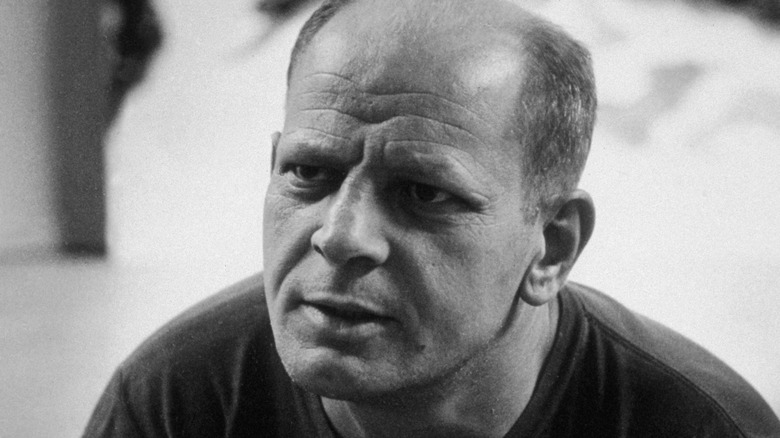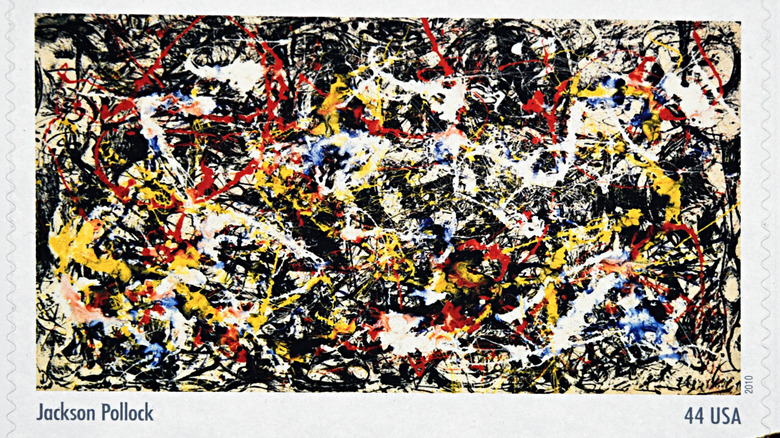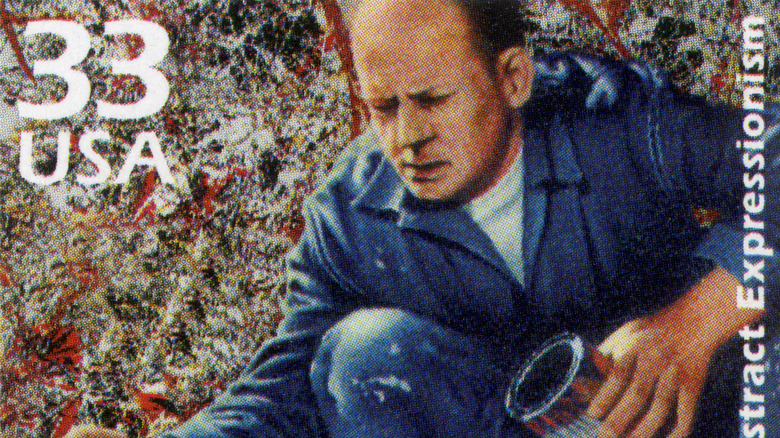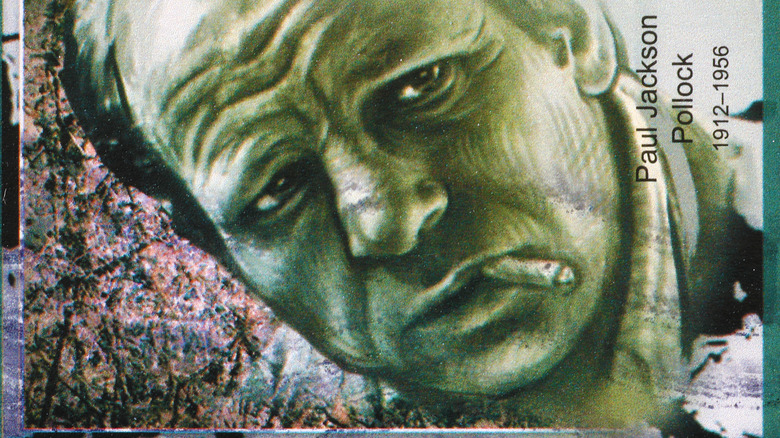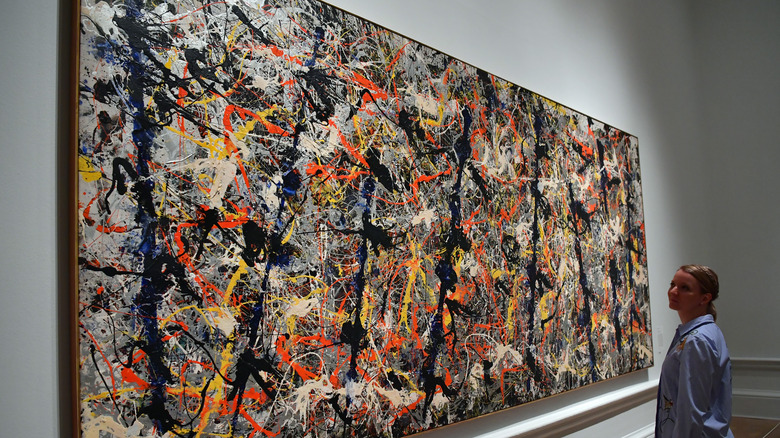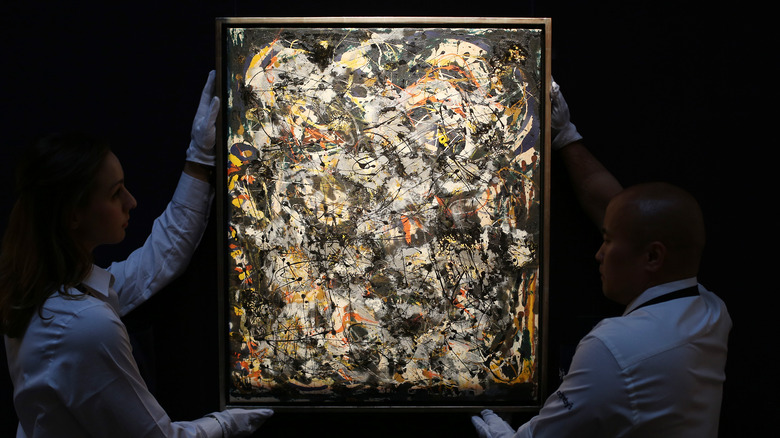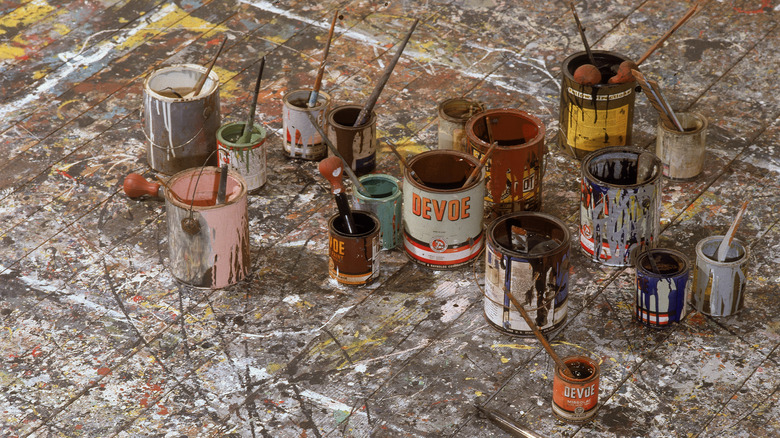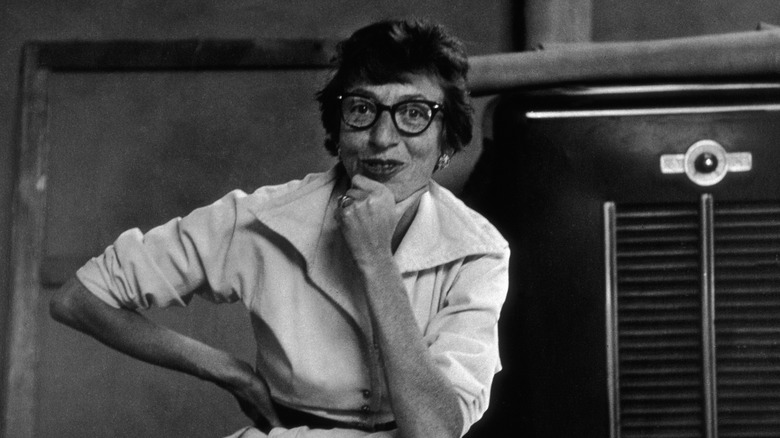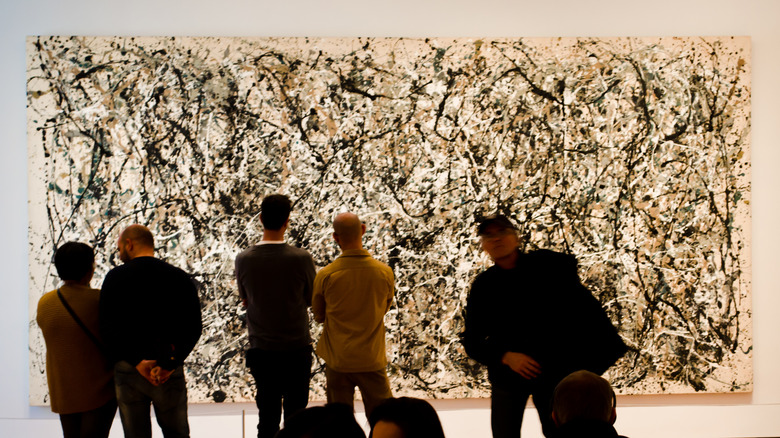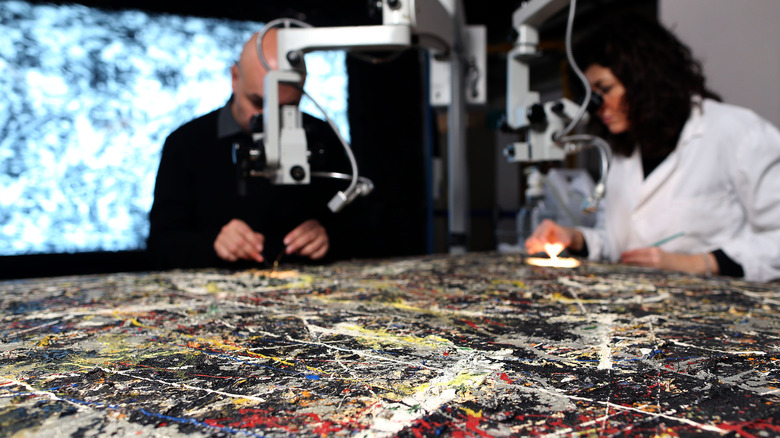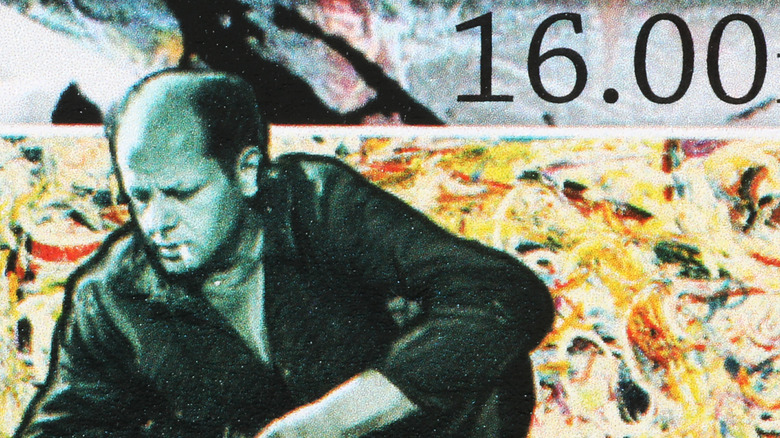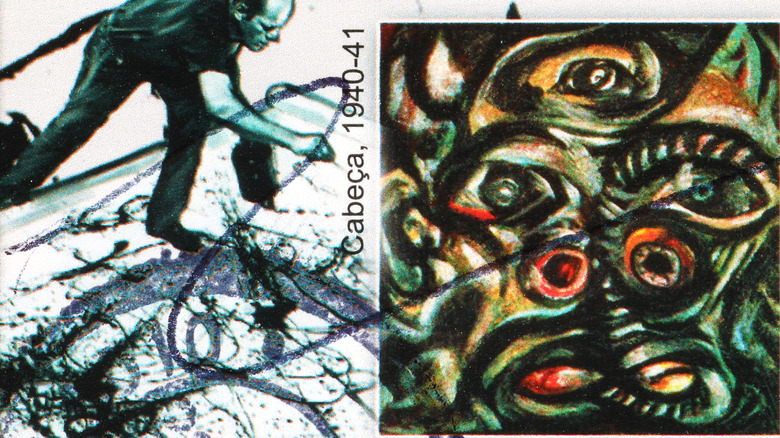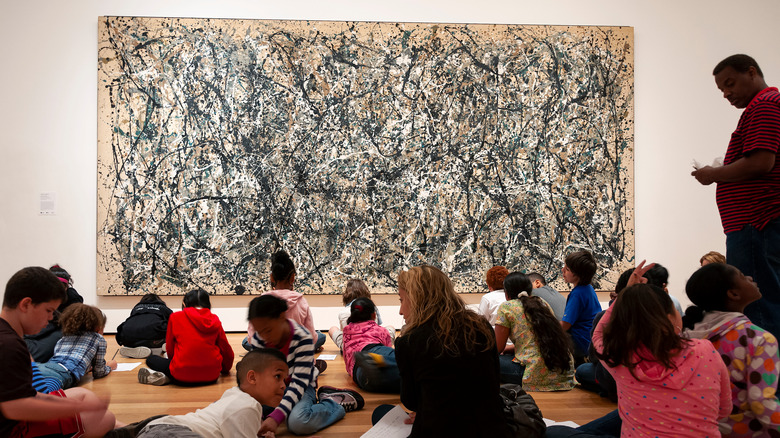The Tragic Real-Life Story Of Jackson Pollock
You can't talk about abstract expressionism without talking about Jackson Pollock — he's the artist who chose to lay a canvas on the floor and drip paint all over it, often using his body (not a brush) as a tool. He showed spontaneous expressions of intense personal feelings in a way that no one had seen before in the American art world. But the intense emotions Pollock depicted in his artwork came from a pretty dark place.
As Biography reports, depression, alcoholism, and social awkwardness haunted Pollock for his whole life. His abusive, alcoholic father provided a negative example that Pollock simply couldn't shake as an adult. The New York art scene also proved to bring more hurdles than joy for him. With fame came stern criticism, and so the pressure to prove himself added another layer of anxiety for Pollock. Amidst all this, he rarely made enough money to live comfortably. While producing groundbreaking art, Pollock slowly descended into alcoholism and violent behavior, until his demons got the best of him on August 11, 1956. Here is the tragic real-life story of Jackson Pollock.
The cowboy painter myth was based on a lie
As Simon Whistler of Biographics reports, Paul Jackson Pollock was born on January 28, 1912, in Cody, Wyoming. This is the town that was named after Colonel William Cody, aka Buffalo Bill. Needless to say, when Pollock became known in the art world (particularly in the Western European one, as per Art Forum), he gained the name of the "cowboy painter." Pollock became known as a sort of lone ranger, a half-smoked cigarette always dangling on his lips while he splashed paint over a huge canvas, its immense dimensions evoking the vast spaces of the great Wild West.
But there were a couple of issues with this. First of all, Pollock left Cody when he was 11 months old — as Britannica reports, Pollock would only revisit Cody through his family's photographs. Second of all, the cowboy myth hurt Pollock, as it created an image that he fought to disprove all his adult life. As per Art Forum's William Rubin, the cowboy painter myth often meant that Pollock was seen as "naive, unconscious of, or outside, any traditions of art, and hence 'styleless'." Pollock hated this — as Art and Antiques Magazine reports, he once sent an angry telegram to Time magazine for calling his art "chaos." Perhaps it was a romantic myth to European art lovers, but the "cowboy painter" was far from what Pollock was trying to convey through his art.
His father was abusive (and Pollock copied his behavior)
Jackson Pollock's father, LeRoy, was a government land surveyor and a farmer, according to Biography. As per Simon Whistler's Biographics, LeRoy Pollock was born LeRoy McCoy, but after he lost both his parents at a very young age, he was adopted by his neighbors, the Pollocks. Unfortunately, LeRoy Pollock was a violent alcoholic, and he abused his family frequently. He left the family when Pollock was 8 years old, but by then, he'd left his mark on Pollock and his four older brothers.
Furthermore, Pollock didn't cut ties with his father when he grew up. Between 1927 and 1930, Pollock and his brother Sanford worked together with LeRoy Pollock as topographical surveyors. According to Whistler, this is when Pollock began drinking. Alcoholism then followed him throughout his whole adult life. As Art Forum mentions, Pollock sometimes became violent when drinking, and this behavior would often become the most apparent at parties he attended. Although his father set a negative example for young Pollock, the artist copied his behavior, and this eventually brought his downfall.
If you or anyone you know is struggling with addiction issues, help is available. Visit the Substance Abuse and Mental Health Services Administration website or contact SAMHSA's National Helpline at 1-800-662-HELP (4357).
Pollock had poor mental health from a young age
Jackson Pollock might have been known for his alcoholism in the 1940s, but his struggles with mental health had begun long before that. According to Biography, Pollock was a needy child, and he often felt neglected or ignored by his mother. After his father left, Pollock became very close to his older brother, Charles, who was also an artist. (In fact, Charles was the one who inspired Pollock to enter the New York art world in 1930.) But even when living with Charles as an adult, Pollock exhibited clear signs of mental illness.
As Biographics points out, a letter between two of Pollock's brothers emphasizes very evident psychological instability in Pollock, and his troubled childhood was mentioned as the source of these problems. According to York University's Trauma and Mental Health Report, Pollock showed clear signs of bipolar disorder alongside his lifelong problem with alcoholism. In 1937, Pollock started psychiatric treatment for his alcohol addiction. A year, later, he was institutionalized following a nervous breakdown (via Britannica). Unfortunately, even after the four months at the hospital, Pollock showed little signs of change (perhaps none, apart from his stylistic evolution).
If you or someone you know needs help with mental health, please contact the Crisis Text Line by texting HOME to 741741, call the National Alliance on Mental Illness helpline at 1-800-950-NAMI (6264), or visit the National Institute of Mental Health website.
He never felt at home
It can be argued that Jackson Pollock's sense of awkwardness was developed in his first 10 years, as he never truly had a place that he could call home. During Pollock's first decade, his family relocated six times and lived in three states (via Biographics). This was due to his father working as a topographic surveyor, and he would also buy and sell land wherever the opportunities would arise. Hence, Pollock moved from Cody, Wyoming, to San Diego, California. Then, he lived in Phoenix, Arizona, before moving back to California, to Chico. As Britannica reports, Pollock had moved nine times by the age of 16.
His last move with his family was in 1928, to Los Angeles. That's also where Pollock enrolled at Manual Arts High School, his very first art school and first official encounter with the visual arts. Two years later, he moved again, this time of his own volition, to New York to live with his brother Charles. While New York was, arguably, the first place Pollock could call home (as per Biography, he lived in New York and Long Island until his death in 1956), his sense of displacement, social awkwardness, and depression never left him. There are many potential sources for Pollock's struggles, but not having a stable home as a child — or the possibility to grow roots and make friends — was certainly a catalyst.
Pollock repeatedly got kicked out of school
In 1927, Jackson Pollock started attending the Riverside High School in Los Angeles, and from the get-go, he assumed the role of the outcast (via Biographics). He didn't make any friends, and he didn't get along with his teachers either. LeRoy Pollock even expressed his worries in a letter to the school's teachers, but Pollock's behavior would only worsen. When he became violent, he was expelled.
In 1928, at the age of 16, Pollock enrolled at the Manual Arts High School in Los Angeles, where he had painter Frederick John de St. Vrain Schwankovsky as a mentor. Schwankovsky trained Pollock in the visual arts and also imbued him with a love for the occult — as Britannica reports, Schwankovsky was a member of the Theosophical Society. But Pollock was expelled from the Manual Arts High School, too — twice. According to Biographics, this was because Pollock participated in socialist protests, inspired by his father. Pollock became a rebel with a passion for going against authority, but this earned him a lot of trouble and a discontinued education. Pollock would go on to write to his brother Charles that the years of his youth were "a bit of damnable hell."
Psychotherapy didn't help his addiction
As per Britannica, Jackson Pollock's first art mentor, Frederick John de St. Vrain Schwankovsky, contributed to his openness toward psychologist Carl Jung's methods. Following his time in the psychiatric hospital in 1938, Pollock began seeing a psychotherapist for his depression, anger issues, and alcoholism. As Biographics reports, Pollock's first psychotherapist was Dr. Joseph Henderson — Pollock was his patient between 1938 to 1941. Then, Pollock started seeing Dr. Violet Staub de Lazlo for about a year. Both of his psychotherapists worked with Jungian methods, particularly the split between the ego, personal unconscious, and collective unconscious.
During his therapy sessions, Pollock began drawing as a way to express his repressed memories or difficult emotions. These drawings demonstrate his change in style from figurative painting to the very abstract expressionism he helped lay the groundwork for. But there's a sad twist to this story: While therapy helped Pollock shape his unique art technique, it did little to alleviate his mental struggles. In fact, alcoholism eventually led to his untimely death — as Biography reports, Pollock died in a car crash while driving under the influence.
If you or anyone you know is struggling with addiction issues, help is available. Visit the Substance Abuse and Mental Health Services Administration website or contact SAMHSA's National Helpline at 1-800-662-HELP (4357).
His marriage was (at the very least) tumultuous
According to Biography, Jackson Pollock began dating fellow artist Lee Krasner in the early 1940s, and by late 1945, they were married. This was around the same time wealthy art collector Peggy Guggenheim discovered Pollock and ignored Krasner — as Biographics reports, Guggenheim was infatuated with Pollock, so there was a sense of competition between the two women. But this is the least tumultuous part of Pollock's marriage to Krasner. Although they moved to Long Island and Pollock finally had a large studio (converted from an old barn), he wasn't happy.
As Britannica reports, his drinking and violent behavior continued, and Krasner often acted as a pillar, both at home and in the art world. (She managed his artwork and deals with Guggenheim.) Instead of getting better, Pollock descended into his self-destructive habits, all the while clinging to Krasner more and more. Krasner stopped working altogether just to care for Pollock, and the dynamic between the two took a turn for the worse. In the mid-1950s, Pollock began cheating on Krasner, eventually driving her to move to Paris in 1956.
Tabloids and journalists kept sensationalizing his story
According to The New York Times, the 1989 biography "Jackson Pollock: An American Saga" depicts Pollock as gay and oftentimes confused about his sexuality. Pollock's brother Frank said the statements in the book were false, and biographer Jeffrey Potter told The New York Times that Pollock was clearly asexual. The book also claims that Pollock was inspired by his father urinating on a rock when creating his famous "drip" paint technique. Pollock's nephew, Jason McCoy, commented on the biography: "It seemed to me they had done an inordinate and quite wonderful job of research, but the way it read was essentially sensationalist."
Although the biography was published after Pollock's death, sensationalism followed the artist during his lifetime, too. According to Art Forum, he became surrounded by myths, as most critics found it easier to create these than to struggle and understand abstract expressionism at its beginning. As the "Jackson Pollock: Blue Poles" documentary shows, Pollock wanted his art to be simple and blunt, emulating prehistoric art as well as Native American techniques. Instead, he was made into a strange character: Per Britannica, his alcoholism and social awkwardness were exploited by critics and journalists. Unfortunately, as Biography suggests, as Pollock felt criticized and misunderstood, he also felt the pressure to self-promote, which led to even more drinking.
He was highly criticized for his art
Myths and sensationalism increased posthumously for Pollock, but it was stern criticism that hurt him the most while he was alive. In the 1940-1950s, the art world wasn't precisely ready for his groundbreaking style, and so various critics mocked him and despised his art. As per Britannica, Pollock was often seen as a strange, capricious artist who had no technique or "actual" painting skills. The criticism culminated in 1950, after Pollock exhibited his art at the Venice Biennale (via Art and Antiques Magazine). Art critic Bruno Alfieri described Pollock's art as "chaos... absolute lack of harmony... complete lack of structural organization... total absence of technique, however rudimentary... once again, chaos."
Later that year, Time magazine also called Pollock's work "chaos." Pollock thus replied with an angry telegram: "NO CHAOS DAMN IT." In 1956, Time also nicknamed Pollock "Jack the Dripper." It's easy to imagine how these pejorative remarks and unforgiving reviews hurt Pollock and pushed him toward his downfall.
Although he was famous, he barely made any money
Today, we might say any publicity is good publicity. But for Jackson Pollock, his divisive status, even though it earned him a fair amount of attention, didn't earn him any money. He never sold a painting for more than $10,000 and often experienced financial hardship (via Britannica). His work was more appreciated in Western Europe than it was in the United States, but the prices of his paintings only increased after his death. In "Jackson Pollock: Blue Poles," Lee Krasner confesses Pollock sold his "Blue Poles" painting for $6,000, which was a high price compared to what he usually earned. As The Conversation reports, in 1973, National Gallery of Australia director James Mollison purchased the painting for $1.3 million AUD — the highest price ever paid for a contemporary American painting at the time. As per NMA, its value was estimated at $350 million in 2016.
In the 1950s, Pollock's health worsened, and so did his heavy alcohol use — as Biography reports, he often spent his evenings at the Cedar Bar, getting into violent brawls with his friends. During his last years, he barely produced any paintings, and he had abandoned his previous techniques, instead using black and white (via The Guardian). Echoing Vincent van Gogh's tragic story, Pollock's declining mental health meant he also died in poverty.
If you or anyone you know is struggling with addiction issues, help is available. Visit the Substance Abuse and Mental Health Services Administration website or contact SAMHSA's National Helpline at 1-800-662-HELP (4357).
His alcoholism eventually led to his death
By 1956, Jackson Pollock had reached rock bottom. He had pushed his supportive wife away with his abusive and disloyal behavior, and he had succumbed to alcoholism, having lost the will to paint. And soon, it would all come to a bitter conclusion that would cost the lives of others. As Biography and The Guardian report, just after 10 p.m. on August 11, 1956, Pollock drove his convertible Oldsmobile into a tree at 80 mph. Pollock was decapitated, and passenger Edith Metzger was also killed. Ruth Kligman, Pollock's mistress, was thrown out of the car and survived the crash.
Having learned about Pollock's violent death, Lee Krasner returned to the United States and buried her husband. She also went into mourning for the rest of her life. Pollock was given a memorial in December 1956 at the Museum of Modern Art in New York City. His alcohol-fuelled death (that brought another death with it) stands as a tragic end to a tragic life, ridden with mental and financial struggles. And the tragedy continues after his death.
Pollock's girlfriend didn't care about his legacy
Ruth Kligman, Jackson Pollock's girlfriend at the time of his death, was never interested in preserving his legacy, even though she was by his side for the last months of his life. As Vanity Fair reports, Kligman showed questionable behavior repeatedly around Pollock and his wife, Lee Krasner. She reportedly moved into Pollock's home the day his wife left for Paris, hurt by his cheating. After the car crash (and Pollock's death) on August 11, 1956, Kligman sued Krasner, seeking $100,000 for damages. A year later, she started an affair with artist Willem de Kooning, Pollock's archnemesis in the world of abstract expressionism.
It was Krasner who continued Pollock's legacy, promoting and selling his paintings to museums worldwide. As art critic Harold Rosenberg commented (via Vanity Fair), "[She] almost single-handedly forced up prices for contemporary American abstract art after [Pollock's] death." Krasner also formed the Pollock-Krasner Foundation for grants to promising young artists (via Biography). The fact that it was Krasner — not Kligman — who preserved Pollock's legacy, albeit unsurprising, adds another tragic layer to Pollock's story, as Krasner was the one neglected and abused by Pollock for years.
